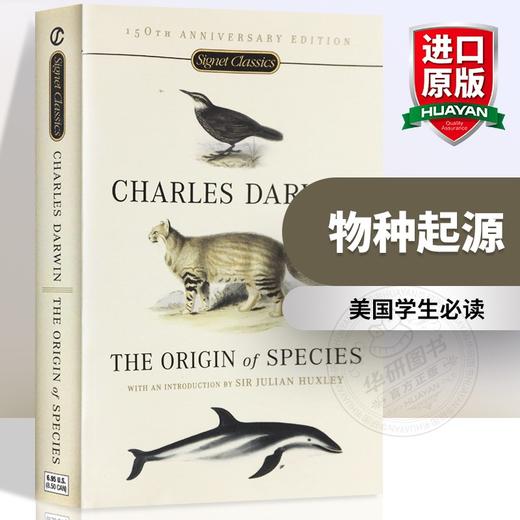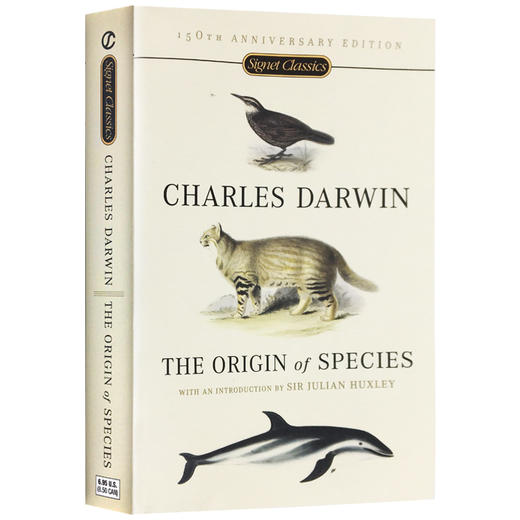正版 物种起源 英文原版书 The Origin of Species 达尔文生物进化经典名著 英文版进口书籍
| 运费: | ¥ 0.00-999.00 |
| 库存: | 101 件 |
商品详情
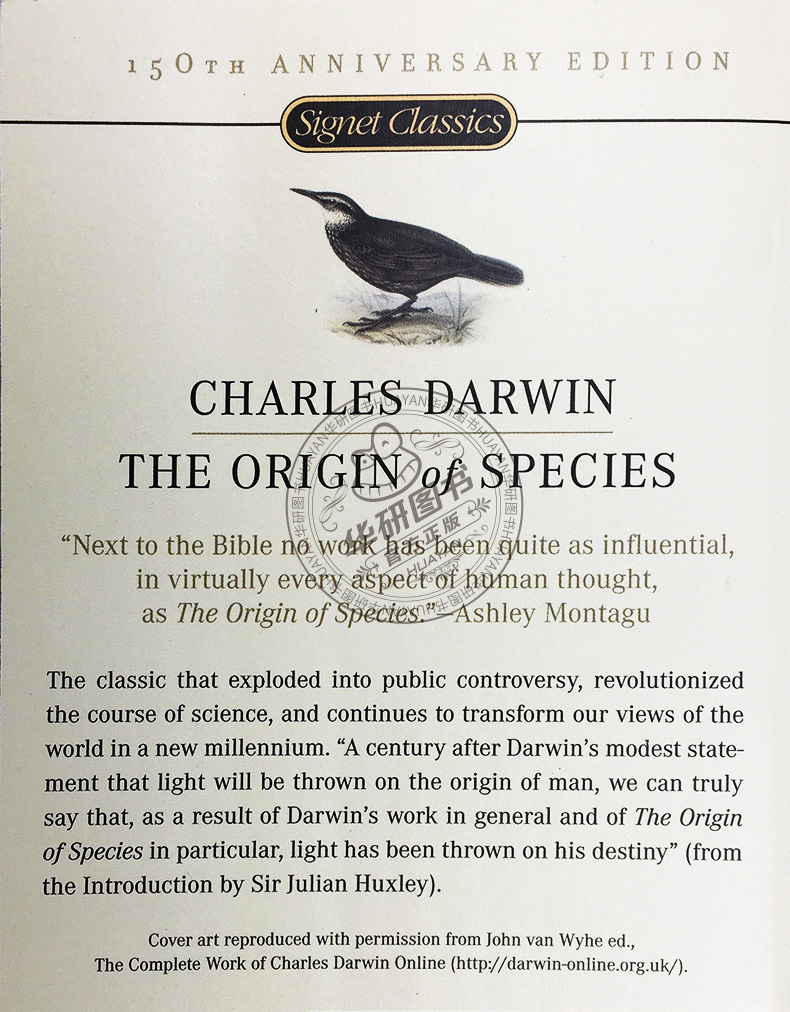
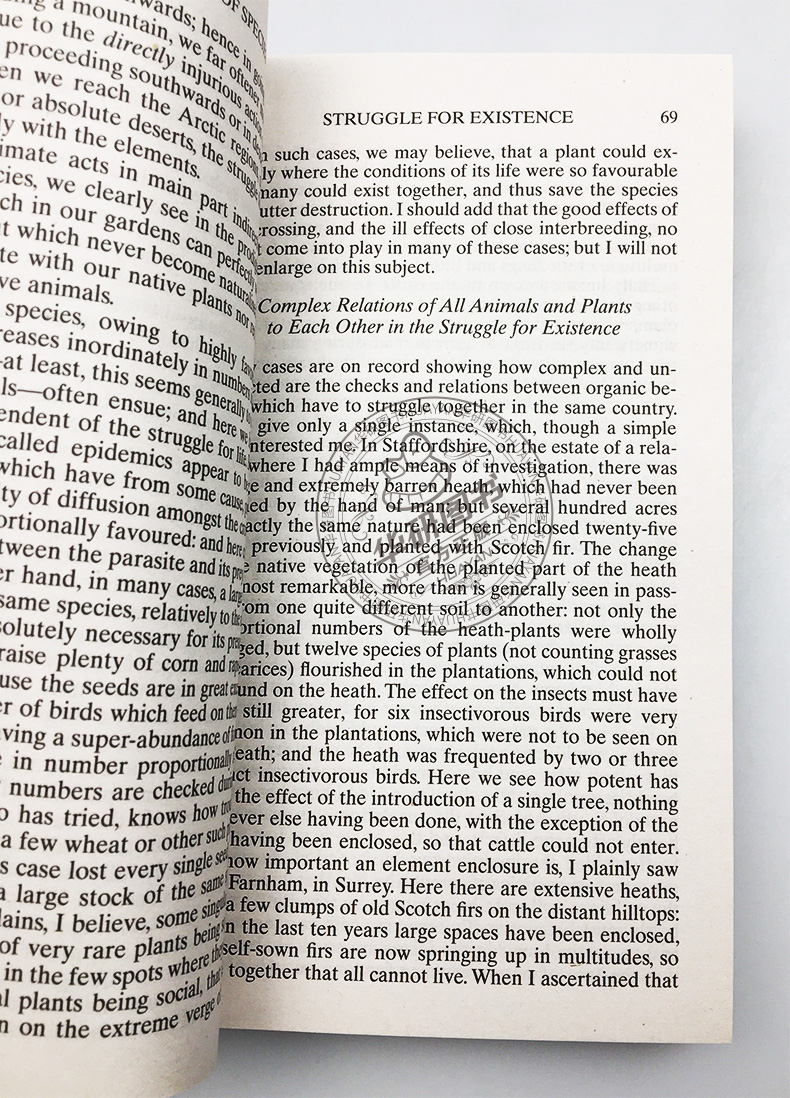
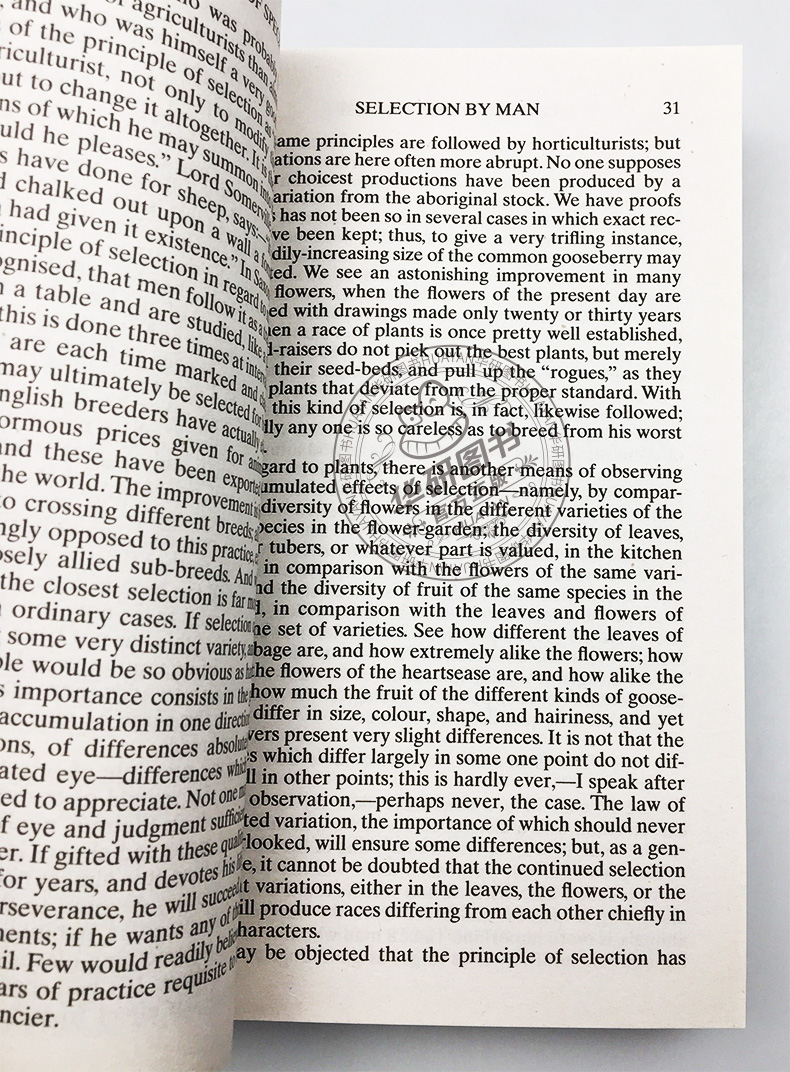
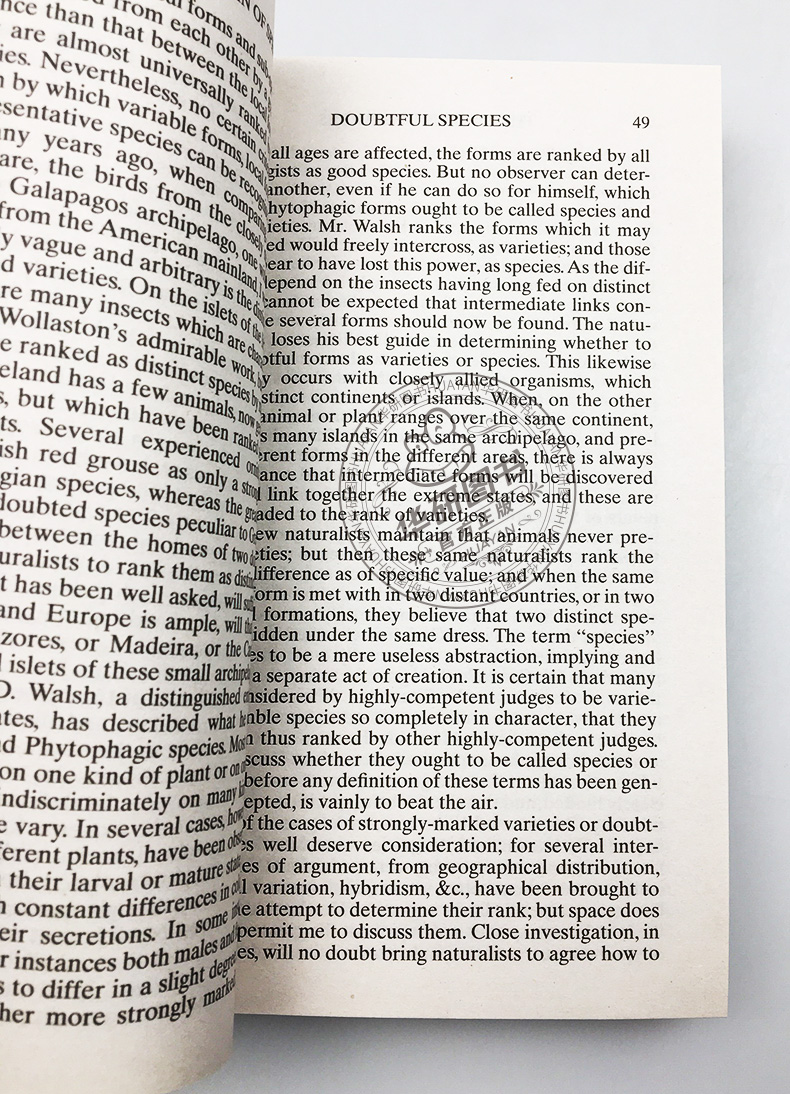

书名:The Origin of Species 物种起源
难度:Lexile蓝思阅读指数1430L
作者:Charles Darwin查尔斯•达尔文
出版社名称:Signet Classics
出版时间:2003
语种:英文
ISBN:9780451529060
商品尺寸:10.6 x2.2 x 17.3 cm
包装:简装
页数:576 (以实物为准)

The Origin of Species《物种起源》是达尔文论述生物进化的重要著作。该书大概是19世纪具有争议的著作,其中的观点大多数为当今的科学界普遍接受。早在达尔文之前,就已经有人提出过进化的观点。但是真正使生物进化论为世人所关注的是达尔文于1859年出版的《物种起源》,因为这本书的结论建立在大量的一手考查资料基础之上。它不仅带来了生物科学的根本变革,而且使人们的世界观发生了重大的改变。
达尔文是在“贝格尔号”舰上担任博物学家时进行的五年航海考查时期,通过考查和对比各地的物种性状,得到了物种渐变的结论。航海结束后,达尔文又通过搜集动物和植物在家养条件下发生变异的材料,根据人工选择的原理得到了自然选择的思想。遗传变异、生存斗争、自然选择学说是《物种起源》一书的主要内容。
本书为Signet Classics推出的英文原版,包含由Sir Julian Huxley写的序言,有助于理解书本内容。书本轻巧便携,内容完整无删减。
Charles Darwin’s classic that exploded into public controversy, revolutionized the course of science, and continues to transform our views of the world.
Few other books have created such a lasting storm of controversy as The Origin of Species. Darwin’s theory that species derive from other species by a gradual evolutionary process and that the average level of each species is heightened by the “survival of the fittest” stirred up popular debate to fever pitch. Its acceptance revolutionized the course of science.
As Sir Julian Huxley, the noted biologist, points out in his illuminating introduction, the importance of Darwin’s contribution to modern scientific knowledge is almost impossible to evaluate: “a truly great book, one which can still be read with profit by professional biologist.”
Includes an Introduction by Sir Julian Huxley
Review:
“Next to the Bible no work has been quite as influential, in virtually every aspect of human thought, as The Origin of Species.” —Ashley Montagu
“Darwin was one of history’s towering geniuses and ranks with the greatest heroes of man’s intellectual progress.” —George Gaylord Simpson in The Meaning of Evolution
“It is clear that here is one of the most important contributions ever made to philosophic science; and it is at least behooving on scientists, in the light of the accumulation of evidence which the author has summoned in support of his theory, to reconsider the grounds on which their present doctrine of the origin of species is based.” —The New York Times
“Amazingly, 150 years after the publication of The Origin of Species, Darwin’s seminal work on the theory of evolution remains the authoritative tract on the subject.” —Library Journal

查尔斯•达尔文,英国博物学家、生物学家,进化论的奠基人。达尔文曾以博物学家的身份参加了英国派遣的环球航行,做了五年的科学考察。经过潜心研究,出版了震动整个学术界的《物种起源》,提出了“生物进化论”学说,从而摧毁了各种唯心的“神造论”和“物种不变论”。“进化论”被学界誉为19世纪自然科学的三大发现之一。其著作还有《人类起源与性选择》《人类和动物情感的表达》《贝格尔号航行期内的动物志》《贝格尔号航行期内的地质学》等。
Charles Robert Darwin was born in 1809 in Shrewsbury, England. At Cambridge University he formed a friendship with J. S. Henslow, a professor of botany, and that association, along with his enthusiasm for collecting beetles, led to “a burning zeal,” as he wrote in his Autobiography, for the natural sciences. A voyage to the Southern Hemisphere on the H.M.S. Beagle between 1831 and 1836 would lay the foundation for The Origin of Species, published in 1859. His other works include The Descent of Man, and Selection in Relation to Sex (1871) and Recollections of My Mind and Character, also titled Autobiography (1887). Charles Darwin’s Diary of the Voyage of the H.M.S. Beagle was published posthumously in 1933.

Chapter One Variation Under Domestication
Causes of Variability—Effects of Habit—Correlation of Growth—Inheritance—Character of Domestic Varieties—Difficulty of distinguishing between Varieties and Species—Origin of Domestic Varieties from one or more Species—Domestic Pigeons, their Differences and Origin—Principle of Selection anciently followed, its Effects—Methodical and Unconscious Selection—Unknown Origin of our Domestic Productions—Circumstances favourable to Man’s power of Selection
WHEN WE look to the individuals of the same variety or sub-variety of our older cultivated plants and animals, one of the first points which strikes us, is, that they generally differ much more from each other, than do the individuals of any one species or variety in a state of nature. When we reflect on the vast diversity of the plants and animals which have been cultivated, and which have varied during all ages under the most different climates and treatment, I think we are driven to conclude that this greater variability is simply due to our domestic productions having been raised under conditions of life not so uniform as, and somewhat different from, those to which the parent species have been exposed under nature. There is, also, I think, some probability in the view propounded by Andrew Knight, that this variability may be partly connected with excess of food. It seems pretty clear that organic beings must be exposed during several generations to the new conditions of life to cause any appreciable amount of variation; and that when the organisation has once begun to vary, it generally continues to vary for many generations. No case is on record of a variable being ceasing to be variable under cultivation. Our oldest cultivated plants, such as wheat, still often yield new varieties: our oldest domesticated animals are still capable of rapid improvement or modification.
It has been disputed at what period of life the causes of variability, whatever they may be, generally act; whether during the early or late period of development of the embryo, or at the instant of conception. Geoffroy St. Hilaire’s experiments show that unnatural treatment of the embryo causes monstrosities; and monstrosities cannot be separated by any clear line of distinction from mere variations. But I am strongly inclined to suspect that the most frequent cause of variability may be attributed to the male and female reproductive elements having been affected prior to the act of conception. Several reasons make me believe in this; but the chief one is the remarkable effect which confinement or cultivation has on the functions of the reproductive system; this system appearing to be far more susceptible than any other part of the organization, to the action of any change in the conditions of life. Nothing is more easy than to tame an animal, and few things more difficult than to get it to breed freely under confinement, even in the many cases when the male and female unite. How many animals there are which will not breed, though living long under not very close confinement in their native country! This is generally attributed to vitiated instincts; but how many cultivated plants display the utmost vigour, and yet rarely or never seed! In some few such cases it has been found out that very trifling changes, such as a little more or less water at some particular period of growth, will determine whether or not the plant sets a seed. I cannot here enter on the copious details which I have collected on this curious subject; but to show how singular the laws are which determine the reproduction of animals under confinement, I may just mention that carnivorous animals, even from the tropics, breed in this country pretty freely under confinement, with the exception of the plantigrades or bear family; whereas, carnivorous birds, with the rarest exceptions, hardly ever lay fertile eggs. Many exotic plants have pollen utterly worthless, in the same exact condition as in the most sterile hybrids. When, on the one hand, we see domesticated animals and plants, though often weak and sickly, yet breeding quite freely under confinement; and when, on the other hand, we see individuals, though taken young from a state of nature, perfectly tamed, long-lived, and healthy (of which I could give numerous instances), yet having their reproductive system so seriously affected by unperceived causes as to fail in acting, we need not be surprised at this system, when it does act under confinement, acting not quite regularly, and producing offspring not perfectly like their parents or variable.
Sterility has been said to be the bane of horticulture; but on this view we owe variability to the same cause which produces sterility; and variability is the source of all the choicest productions of the garden. I may add, that as some organisms will breed most freely under the most unnatural conditions (for instance, the rabbit and ferret kept in hutches), showing that their reproductive system has not been thus affected; so will some animals and plants withstand domestication or cultivation, and vary very slightly—perhaps hardly more than in a state of nature.
A long list could easily be given of “sporting plants;” by this term gardeners mean a single bud or offset, which suddenly assumes a new and sometimes very different character from that of the rest of the plant. Such buds can be propagated by grafting, &c., and sometimes by seed. These “sports” are extremely rare under nature, but far from rare under cultivation; and in this case we see that the treatment of the parent has affected a bud or offset, and not the ovules or pollen. But it is the opinion of most physiologists that there is no essential difference between a bud and an ovule in their earliest stages of formation; so that, in fact, ‘sports’ support my view, that variability may be largely attributed to the ovules or pollen, or to both, having been affected by the treatment of the parent prior to the act of conception. These cases anyhow show that variation is not necessarily connected, as some authors have supposed, with the act of generation.
- 华研外语批发分销官方旗舰店 (微信公众号认证)
- 本店是“华研外语”品牌商自营店,全国所有“华研外语”、“华研教育”品牌图书都是我司出版发行的,本店为华研官方源头出货,所有图书均为正规正版,拥有实惠与正版的保障!!!
- 扫描二维码,访问我们的微信店铺
- 随时随地的购物、客服咨询、查询订单和物流...
